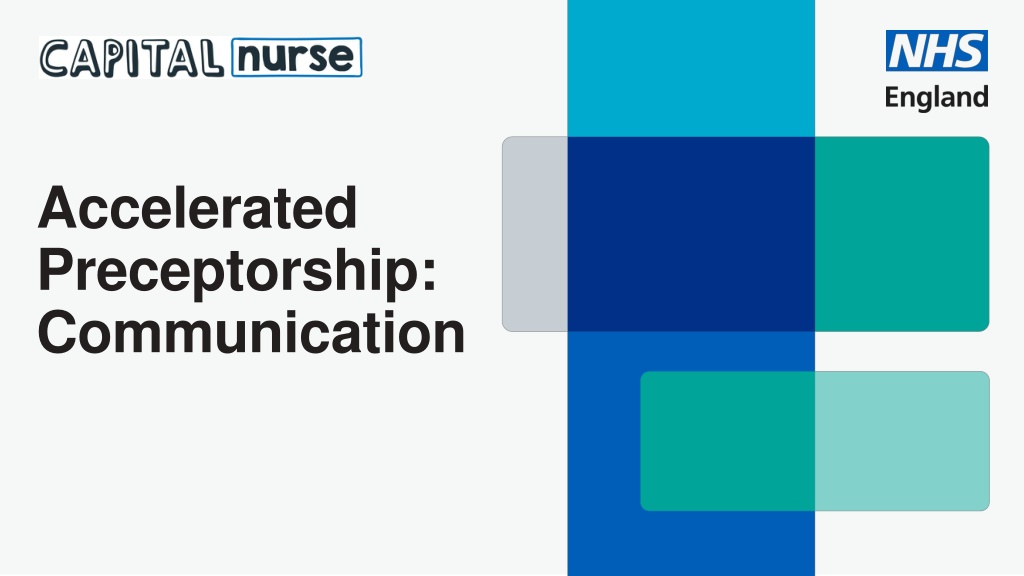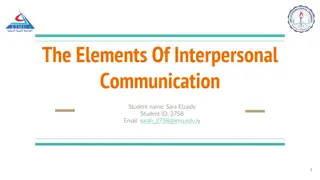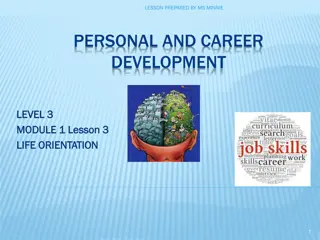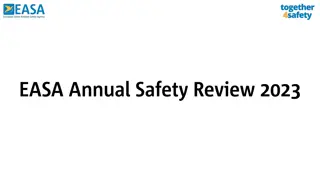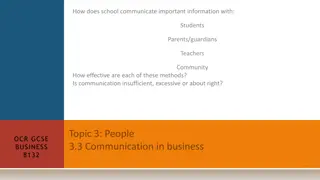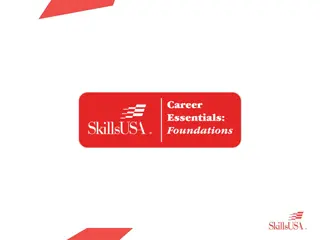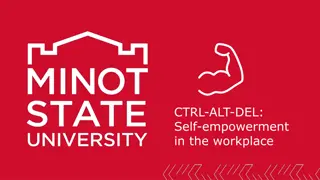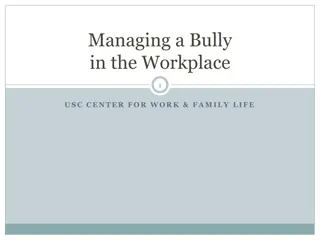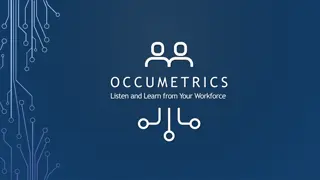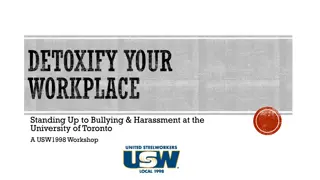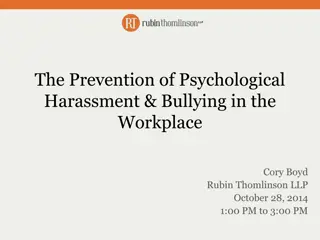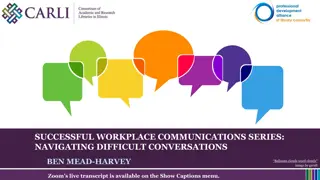Mastering Effective Communication in the Workplace
Explore the significance of effective communication, various communication preferences, and strategies to enhance communication dynamics. Dive into non-verbal cues, listening skills, and overcoming barriers to communication. Understand the impact of different communication channels and how to engage with non-verbal patients effectively.
- Communication Skills
- Workplace Communication
- Non-verbal Communication
- Effective Communication
- Communication Strategies
Download Presentation

Please find below an Image/Link to download the presentation.
The content on the website is provided AS IS for your information and personal use only. It may not be sold, licensed, or shared on other websites without obtaining consent from the author. Download presentation by click this link. If you encounter any issues during the download, it is possible that the publisher has removed the file from their server.
E N D
Presentation Transcript
Accelerated Preceptorship: Communication
Objectives By the end of the session, you will understand: the importance of effective communication at work how to promote effective communication different communication preferences and the impact. 2
Topics Communication dynamics Impact of communication in workplace Non-verbal communication Listening skills Barriers to communication and strategies Visual, auditory and kinestheti (VAK) styles Transactional analysis 3
Communication process Based on Shannon and Weaver s communication model (1949), communication is seen as a chain along which a message passes through five stages: The message is sent in whichever format (verbal, electronic, written) They put the message into a code subconsciously Sender has a message to send The message is received and decoded subconsciously The message is understood Shannon and Weaver, 1949 4
Impact of communication channels Research conducted by Albert Mehrabin showed that the words used are actually the lowest factor in understanding. Body language and tone account for more impact, however, are often given less consideration in communication. Telephone Face-to-face 20 per cent 7 per cent Words 80 per cent 25 per cent Tone - 68 per cent Body language Albert Mehrabin, 1970s 5
Non-verbal communication Non-verbal communication involves: body language eye contact voice, tone, expression, emphasis and quality gestures facial expressions use of touch and the zones around us head movements postures. 6
Reflection For patients with learning disabilities or communication impairments (for example, non-verbal), how would you go about gaining consent? Why is it important to use different methods of communication? 7
Communicating with non-verbal patients Apps which detect eye movement PECS (Picture Exchange Communication System) Emoji cards Sign language, braille Family members (as appropriate) 8
Listening skills Focus on the other person Observe facial expression and gestures Listen to the tone and emphasis Listen to understand Avoid being distracted or interrupting Empathise with other person Reflect back your understanding 9
L I S T E N look interested information seeking ask questions stick to the subject concerned and focus test your understanding with feedback and summary evaluate the message to check interpretation neutralise your thoughts against previous assumptions 10
Reflection Consider the impact of communication in the workplace What is the result of poor communication? And the result of good communication? Can you provide examples of both from your own experience? 11
Impact of communication Communication can have both positive and negative results on relationships in the workplace and patient care: Positive Negative small things get missed misunderstandings leading to mistakes blame culture may develop staff feel demotivated increased attrition poor team working with impact on service patient care suffers. develops trust between staff and patients promotes a positive working environment improves team working promotes shared responsibility encourages staff to share information encourages transparency and honesty. 12
Examples Poor communication Good communication An eating disorder patient has the meal plan recorded in notes. Previous staff have deviated from meal plan without communication with doctor / dietitian. When this is highlighted, it means the patient cannot have what they have been having as a snack and causes patient distress and anxiety as they can t understand reason why not. A poorly patient on ward is deteriorating. Nurse escalates to doctor who reviews immediately. The doctor speaks directly to nurse and documents plan which is carried out correctly. The patient is then safe for transfer and all appropriate team members made aware and patient transferred out swiftly. 13
Reasons Swiss Cheese model Reason (1991) developed the Swiss Cheese Model which illustrates the impact of poor communication on patient health and safety: Each slice of Swiss Cheese has holes. These holes are the potential issues that could occur. During the different stages (slices), if the holes align, it can create an incident. 14
Example of Swiss Cheese model Slice one: staffing big hole is you re short staffed Slice two: bloods need to be taken from patient. Shortcomings: lack of trained staff, patient refusal, patient on ward Slice three: bloods taken. Shortcomings include blood bottles incorrectly labelled, not sent to lab, lost on way to lab, left unlabelled Slice four: bloods results not returned. Shortcomings include not chased during shift, lost enroute, no doctor to review, poor communication from lab Slice four Slice three Outcome: If all shortcomings align and patient does not receive blood results, this can lead to late diagnosis, delayed treatment, anxiety for patient and family, potential for further blood taken. Slice two Slice one 15
Why is communication important? Studies conducted during the past three decades show that the clinician s ability to explain, listen and empathise can have a profound effect on biological and functional health outcomes as well as patient satisfaction and experience of care. Institute of Healthcare Communication, 2011 16
Activity Spend a few moments thinking about the barriers to effective communication both with colleagues and patients / service users For each barrier, identify strategies to overcome these 17
Barriers to communication Language, dialect, jargon, abbreviations Age generational differences in vocabulary Culture and religion Personal style may be positive or negative Timing Position / status / role Inappropriate method or media for message Lack of clarity and consistency Physical environment` Physical or learning disabilities Lack of trust or relationship 18
Overcoming barriers Choose most appropriate method / media for individual, any special requirements and the message itself Consider the environment Clear, concise, simple and direct Avoid information overload Be confident in yourself and quietly assertive Observe and listen Check understanding 19
SBAR SBAR is a structured form of communication to facilitate accurate transfer of information between individuals. It is used in different contexts with the aim of reducing barriers and adding clarity. SBAR includes standardized prompt questions for each of the four stages. S Situation B Background A Assessment R Recommendation 20
SBAR Identify self, role, department Identify patient and reason for call Describe concern S Reason for admission Explain history Provide information B Critical assessment Concerns Clinical impression A Explain what is needed Be specific and clarify Make suggestions R NHS England, 2021 21
SBAR Example of Handover Hello, I m Maria, a band 5 nurse in paediatric Accident and Emergency A five-year-old girl patient admitted to ward with D and V, on IV fluids for observation. Requires a cubicle. Dad is resident S Patient x has had D and V for four days with blood in stool. Nobody in family is unwell. Recently travelled to Thailand and returned one week ago. No past medical history. No known drug allergies. No family history of bowel problems. B A airway patent. B self-ventilating in air. No increase work of breathing. Saturation stable and respiratory rate stable C increased heart rate and low blood pressure. Capillary refill time is 3 seconds. No temperature. Pale in colour; skin slightly mottled. Bloods taken D alert on AVPU scale, GCS = 15, pupils equal and reacting to light E no rashes or bruising on skin. Skin is mottled. Cannulate in situ in right hand. F on full maintenance IV fluids running at 62ml per hour of 0.9 per cent saline and 5 per cent dextrose. Parents report three loose stools at home today, has had none since in hospital. S Dad resident and Mum to arrive this afternoon. No siblings at home A Continue IV fluids. Await blood results. Send urine and stool sample. Monitor observations. Give paracetamol for pain and anti-emetics for vomiting. Restrict input and output. Ward doctors to review R 22
Reflection Consider a recent communication / query / handover you had and how you could have improved it using SBAR 23
VAK communication styles Visual (V) communicators around 65 per cent: prefer face to face contact as they take the message from the eye contact and body language. Auditory (A) communicators around 30 per cent: take the message from the tone, expression and emphasis of the voice. They do not need to see other people, nor to make eye contact. Kinaesthetic (K) communicators around 5 per cent: like to be around people, the meaning of communication comes from body language and the sense of the other person. 24
Reflection Consider where your preferences are (visual, auditory or kinaesthetic) How does this affect your preferred method and style of communication? How may it impact on your communication and relationship with others? 25
Building rapport Building rapport with another person can be the difference between success and failure in communication. By building rapport with the other person, they will begin to trust you and communication becomes much easier and more effective. We can begin by smiling, using positive eye contact and tone of voice. Other techniques include: mirroring and matching pacing and leading. 26
Mirroring and matching Mirroring and matching are NLP techniques that are used to build rapport sub-consciously. Although a form of mimicry, it should be very subtle and includes matching or mirroring the other person in terms of: posture how they are sitting / standing, body position (crossed legs or arms) tone of voice eye contact body language. When someone is mis-matching, the other person will feel uncomfortable and distrustful. 27
Transactional analysis (TA) Transactional analysis was developed by Eric Berne (1964) as we communicate at both a psychological and social level. It considers three different ego states used in our transactions with others. These are: 1. 2. 3. Parent Adult Child. In the workplace, transactions should take place between adult ego states and problems occur when different ego states are adopted. For example, a difficult person may assume the ego state of a child to try and get their own way, causing the other person in the transaction to adopt the ego state of a parent, resulting in an ineffective dialogue or a crossed transaction. 28
Parent Nurturing Parent Critical/ Controlling Parent Should, Must, Don t, good, Bad, Haven t you?, Why not? Harsh, Abrupt, Authoritative, dismissive, patronising Finger pointing, arms crossed, rolling eyes, scowling, furrowed brow, Standing over someone Seeks to keep the child contented and calm their fears, can be overprotective, can stop or hinder the development of others. Words Don t worry, let me help you, it s ok, I ll sort it, Tone (para- verbal) Soothing, consoling, protective Controlling, seeks to make the child do as they say, critical, bossy, rule maker. Body Language Pat on arm, Nodding encouragingly, Smiling, Proud eyes Communication and Leadership: Transactional Analysis Model (Joseph Lynch) 29 29
TA: Ego States Parent Adult Child Nurturing Parent Free Child Adaptive Child Critical Parent Communication and Leadership: Transactional Analysis Model (Joe Lynch) 30
Child Free Child Adaptive Child Please, sorry, I can t, I ll try, Yes of course, I won t, may I? Complaining, surly, appeasing, nodding, sighing, helpless Words I wish, wow, love, hate, I want Unencumbered by rules and what you should do, genuine feelings, immature, inconsiderate. Tone (para- verbal) Joyful, noisy, energetic, emotionally, crying Compliant (learned to do what they were told to be accepted) or Rebellious (fights back against the system), attention seeking. Body Language Exaggerated movements, uninhibited, smiling freely, Head tilt, fidgeting, slouching, downcast, not engaged, Communication and Leadership: Transactional Analysis Model (Joseph Lynch) 31
Adult ADULT Decisions and beliefs are scrutinised. Opinions are made up from rational analysis of all available information. Words How, when, I understand, tell me more, what do you think? let s try, lets find, Calm, clear, even tone, open Tone (para-verbal) Functions in the 'here and now'. Body Language Level eye contact, thoughtful facial expression, relaxed, Logical practical thinking. Communication and Leadership: Transactional Analysis Model (Joseph Lynch) 32
Reflection Consider different situations when you have observed these behaviours and reflect on the impact these had. Could the situation have been managed better if different behaviours had been used? 33
Types of transaction Complementary stable ego states, expected responses. Example: Awful weather today. Response: Yes, it is. Crossed unexpected responses from different ego states, may be unproductive and transaction is unstable. Example: What time is it? Response: Why do you need to know? 34
Transactional analysis P P P P R A A A A S C C C C Crossed Transactions Complementary Transactions 35
Reflection Reflect on examples you have experienced of crossed and complementary transactions and the resulting impact. Consider a recent or past situation that you felt you were lacking in confidence, where you didn t know what to do or felt that you were isolated without support or help. What thoughts were running through your head at the time? Did it trigger an emotional response? What behaviours did you ultimately display? Did you feel fundamentally you re not as good as others? 36
Test yourself! 1. Patient comes up from Accident and Emergency, handed over to ward staff that they have had a septic screen done and started on antibiotics. When nurse looks at drug chart, antibiotics have not been signed for. What do you do: a) call down to Accident and Emergency and speak to a nurse who says they re not 100 per cent sure but don t think they have been done? call and speak to nurse looking after patient who says they have been done? don t call and give them anyway? b) c) 2. An antibiotic is prescribed twice daily for a patient which is usually 8-hourly. As the nurse handing over, do you: a) b) highlight the antibiotic for this patient is 12 hourly instead of 8 hourly? don t mention it, they should check the drug chart? 37
Finally Extensive research has shown that no matter how knowledgeable a clinician might be, if he or she is not able to open good communication with the patient, he or she may be of no help. Institute of Healthcare Communication, 2011 38
Acknowledgements Written and developed by Desiree Cox, Preceptorship Project Manager, CapitalNurse. With thanks to: Joseph Lynch, Practice Educator, Whittington Health Kristen Leonard, Preceptorship Lead, Imperial College Healthcare Hannah Fosberry, Preceptorship Lead, University College London Jake Chambers, Preceptorship Lead, Oxleas Riina Hilton, Preceptorship Lead, North East London NHS Foundation Trust Maddy Cox, Clinical Nurse Specialist, Epsom and St Helier 39
References Berne, E. (1964) Games People Play the Psychology of Human Relationships, London, Penguin Boddy, D. and Buchanan, D. (1992) Take the Lead: Interpersonal Skills for Project Managers, London, Prentice Hall Cox, Desiree (2013). The Hungry Manager, Amazon, UK https://www.managementstudyguide.com/shannon-and-weaver-model-of-communication.htm - accessed 25/7/2023 https://healthcarecomm.org/about-us/impact-of-communication-in-healthcare/ accessed 25/7/2023 https://www.england.nhs.uk/wp-content/uploads/2021/03/qsir-sbar-communication-tool.pdf - accessed 25/7/2023 Mehrabian, Albert (1971). Silent Messages (1st ed.). Belmont, CA: Wadsworth. ISBN 0-534-00910-7 Reason, J. (1997). Managing Risks of Organizational Accidents. Ashgate Publishing Limited, Aldershot, UK Shannon, C. E., & Weaver, W. (1949). The Mathematical Theory of Communication. Urbana, IL: The University of Illinois Press, 1-117 40
